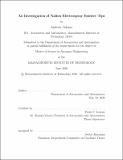An investigation of nafion electrospray emitter tips
Author(s)
Adams, Andrew,S.M.(Andrew C.)Massachusetts Institute of Technology.
Download1241075033-MIT.pdf (52.76Mb)
Other Contributors
Massachusetts Institute of Technology. Department of Aeronautics and Astronautics.
Advisor
Paulo C. Lozano.
Terms of use
Metadata
Show full item recordAbstract
Electrospray propulsion development is limited in large part by the materials with which emitters are manufactured. Emitters must transport ionic liquid to their apex and hold a shape which allows menisci to form and emit pure ions. The motivation for this work was to investigate Nafion, a perfluorinated sulfonic acid ionomer, as an alternative to the porous materials currently used for electrospray emitters. A common, repeatable method of manufacturing Nafion single emitter tips and arrays with different mixture ratios of Nafion and EMI BF₄ is developed and refined. This method utilizes 3D printed negatives with tungsten ILIS emitters to produce a master shape for reusable PDMS molds. Thirteen tips were made using the presented method. Defects are categorized and recorded. Three of the tips were also successfully attached to porous carbon substrates, all of which were mixtures. Molds for arrays were also tested, and an array of pure Nafion was made. The Nafion emitter tips' hydraulic impedance is estimated from geometric parameters and separately calculated from emission characteristics. As part of the calculation, an estimation of (q/m)[subscript avg] is obtained using a previously obtained TOF curve. All tips exceeded the [mathematical expression] impedance threshold to emit pure ions. A tungsten ILIS emitter used as a master for tip shape is tested as a control. Four of thirteen tips were chosen for testing and all successfully emitted ions for a short period. Two emitted for >1 hr and displayed a decreasing emitted current over time, and the emitted current spanned over one order of magnitude (20 to 1000 nA). It is shown that this is likely due to the depletion of an externally wetted meniscus, and the mass flow thereafter was limited by the high hydraulic impedance of the Nafion bulk. The calculated impedance during steady-state emission was significantly lower than estimated for internal tranport alone. Future study should improve understanding of Nafion-EMI BF₄ mixtures and their diffusivity given a pressure difference and a concentration of ionic liquid. In addition, to supplement previous work, an emission tests and an RPA curve are reported for a fifth Nafion tip.
Description
Thesis: S.M., Massachusetts Institute of Technology, Department of Aeronautics and Astronautics, May, 2020 Cataloged from student-submitted PDF of thesis. Includes bibliographical references (pages 121-125).
Date issued
2020Department
Massachusetts Institute of Technology. Department of Aeronautics and AstronauticsPublisher
Massachusetts Institute of Technology
Keywords
Aeronautics and Astronautics.